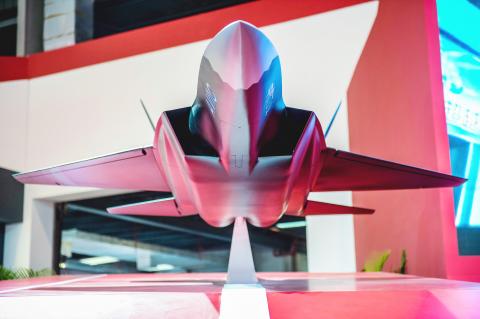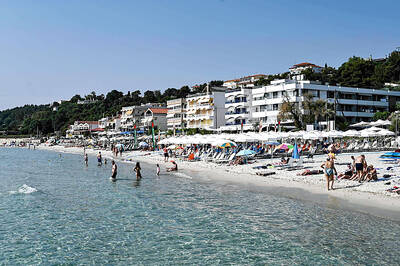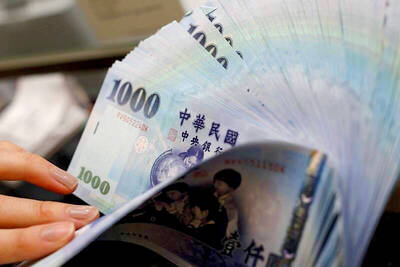China announced 50 new orders for its new Comac C919 passenger jet at the opening of the country’s main air show yesterday and looked set to assist in the rebirth of one of the most famous names in aviation — defunct US carrier Eastern Air Lines.
The dozens of new orders for China’s first large commercial passenger jet were seen dominating the first day of the China International Aviation and Aerospace Exhibition, held every two years in the southern city of Zhuhai, along with fresh evidence of China’s military ambitions.
The latest orders for the 150-seat plane will boost the official total to 380, reaching the state-owned manufacturer’s declared breakeven point of 300 to 400 orders. However, Western analysts say it will be some time before the aircraft, due to make its maiden flight in 2014, proves its viability.

Photo: AFP
The C919 is designed to challenge Airbus SAS and Boeing Co in the largest segment of the US$100 billion annual jetliner market.
Commercial Aircraft Corp of China (COMAC, 中國商用飛機) yesterday said it would sign orders for 20 aircraft each with Joy Air and Hebei Aviation Group, confirming a Reuters report of buying interest from the two Chinese regional carriers.
Its only foreign customer, GECAS, a unit of General Electric Co which co-produces the engines, will buy 10 more, taking its total order for the plane to 20, COMAC said in a statement.

Photo: Reuters
Other potential C919 customers that have already signed tentative agreements include Irish low-cost carrier Ryanair and British Airways, COMAC said.
COMAC also confirmed it would sign a provisional agreement with investors representing Eastern Air Lines, which went bankrupt in 1991. There have been sporadic reports of efforts to relaunch the airline, whose forked logo was seen on display as a backdrop to the signing ceremony due later yesterday.
Once led by former World War I ace Eddie Rickenbacker and later by former Apollo astronaut Frank Borman, Miami-based Eastern Air Lines rose to become one of the largest airlines in the world before losing a battle against low-cost competition.
The air show — attended by a record 650 exhibitors — also featured prototypes of a new Chinese business aircraft and a model of a new stealth fighter China hopes to build for export.
Industry publication Aviation Week noted the model bore a “striking resemblance” to an aircraft recently photographed flying from the Shenyang Aircraft factory, which captured worldwide interest from military analysts and publications.
Separately, Airbus said it expects to build the planned A320neo jet in China, as the planemaker holds discussions about extending the life of its first assembly line outside Europe.
The company is in talks with partners about operating the Tianjin, China, facility through 2025, Airbus’ China head Laurence Barron said yesterday at a press briefing. The factory already makes the current A320 model.
“We can expect to see the neo being assembled here in China in the near future,” Barron said.
The aircraft is due to enter service in 2015. Airbus also builds A320s in France and Germany, and is planning to open a factory in Alabama in the US.
Barron also said the EU’s decision to suspend the introduction of emissions levies on foreign carriers is positive for Airbus in China. The country had been among nations opposing the EU plan because of sovereignty and cost concerns.

Merida Industry Co (美利達) has seen signs of recovery in the US and European markets this year, as customers are gradually depleting their inventories, the bicycle maker told shareholders yesterday. Given robust growth in new orders at its Taiwanese factory, coupled with its subsidiaries’ improving performance, Merida said it remains confident about the bicycle market’s prospects and expects steady growth in its core business this year. CAUTION ON CHINA However, the company must handle the Chinese market with great caution, as sales of road bikes there have declined significantly, affecting its revenue and profitability, Merida said in a statement, adding that it would

Greek tourism student Katerina quit within a month of starting work at a five-star hotel in Halkidiki, one of the country’s top destinations, because she said conditions were so dire. Beyond the bad pay, the 22-year-old said that her working and living conditions were “miserable and unacceptable.” Millions holiday in Greece every year, but its vital tourism industry is finding it harder and harder to recruit Greeks to look after them. “I was asked to work in any department of the hotel where there was a need, from service to cleaning,” said Katerina, a tourism and marketing student, who would

i Gasoline and diesel prices at fuel stations are this week to rise NT$0.1 per liter, as tensions in the Middle East pushed crude oil prices higher last week, CPC Corp, Taiwan (台灣中油) and Formosa Petrochemical Corp (台塑石化) said yesterday. International crude oil prices last week rose for the third consecutive week due to an escalating conflict between Israel and Iran, as the market is concerned that the situation in the Middle East might affect crude oil supply, CPC and Formosa said in separate statements. Front-month Brent crude oil futures — the international oil benchmark — rose 3.75 percent to settle at US$77.01

RISING: Strong exports, and life insurance companies’ efforts to manage currency risks indicates the NT dollar would eventually pass the 29 level, an expert said The New Taiwan dollar yesterday rallied to its strongest in three years amid inflows to the nation’s stock market and broad-based weakness in the US dollar. Exporter sales of the US currency and a repatriation of funds from local asset managers also played a role, said two traders, who asked not to be identified as they were not authorized to speak publicly. State-owned banks were seen buying the greenback yesterday, but only at a moderate scale, the traders said. The local currency gained 0.77 percent, outperforming almost all of its Asian peers, to close at NT$29.165 per US dollar in Taipei trading yesterday. The